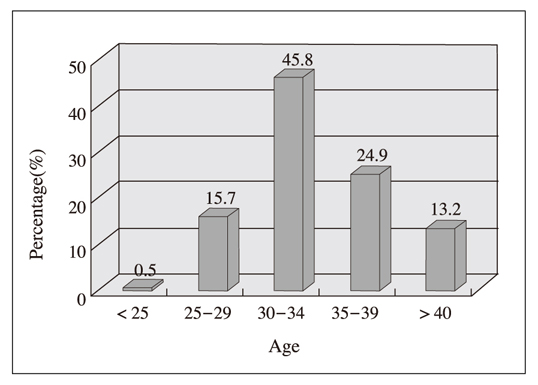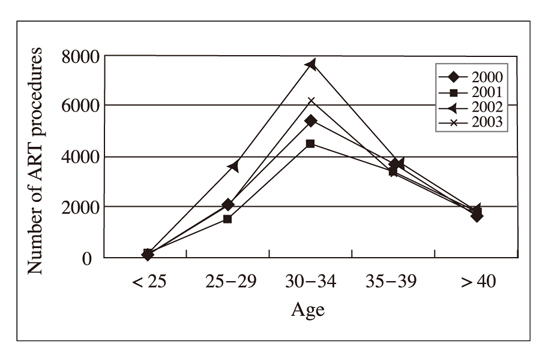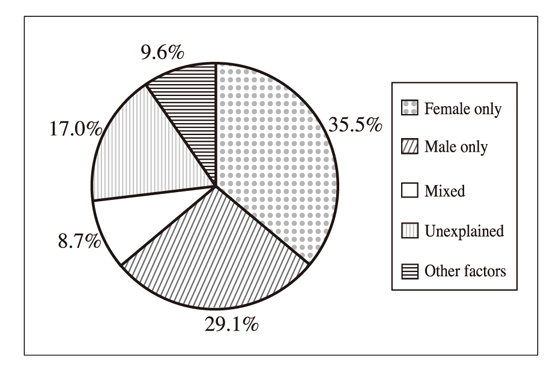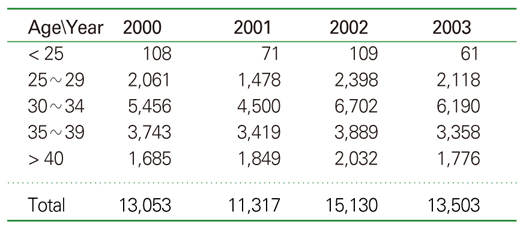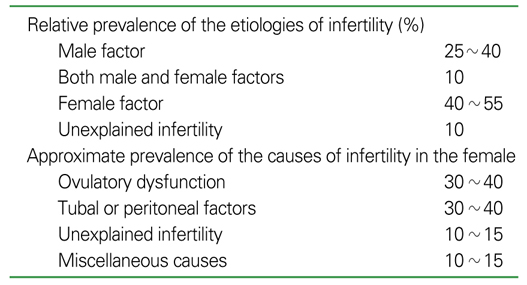 |
 |
- Search
| J Korean Med Assoc > Volume 50(5); 2007 > Article |
Abstract
Pregnancy is a fundamental and evolving process to sustain life in universe. In human, the reproduction is a more complex and highly regulated process. The optimal maturation and the successful fertilization of gamates lead to the successful development of an embryo. Synchronization between embryo development to the blastocyst and differentiation of the endometrium to receptive state is essential to implantation. Greater understanding of sperm and egg development and fertilization is one of the major basics of the clinical application of the assisted reproductive technologies (ART). The abnormalities of these unique processes result in difficult conceiving or infertility. The prevalence of infertility reaches 10~15% of reproductive age couples all over the world, and KIHASA (Korea Institute for Health and Social Affairs) reported in 2003 that it was about 13.5% in Korea. Because most infertile couples, except some specific instances, have difficulties in conceiving, they can be pregnant with infertility treatment such as IVF (in vitro fertilization) or ICSI (intracytoplasmic sperm injection). Generally female fecundability decreases with increasing age. So it is important to try to conceive in earlier ages. Recently, highly developed ART makes it possible to overcome almost all infertility problems.
References
1. In: Speroff L, Fritz MA, editor. Clinical gynecologic endocrinology and infertility 2005;7th ed. Philadelphia: Lippincott Williams & Wilkins. 234-277.
2. Goodman AL, Hodgen GD. The ovulation triad of the primate menstrual cycle. Rec Prog Horm Res 1983;39:1-73.
3. Wang C, Baker HWG, Jennins MG. Interaction between human cervical mucus and sperm surface antibodies. Fertil Steril 1985;44:484-488.
4. Katz DF, Morales P, Samuel SJ, Overstreet JW. Mechanism of filtration of morphologically abnormal human sperm by cervical mucus. Fertil Steril 1990;54:513-516.
5. Hartman JF, Gwatkin RBL. Alteration of sites on the mammalian sperm surface following capacitation. Nature 1971;234:479-481.
6. Basrros C, Yanagimachi R. Introduction of zona reaction in golden hamster eggs by cortical granule material. Nature 1971;233:268-269.
7. Ducibella T. The cortical reaction and development of activation competence in mammalian oocytes. Hum Reprod Update 1996;2:29-42.
8. Tassadon A, Eliyahu E, Shtraizent N, Shalgi R. When a sperm meets an egg: Block to polyspermy. Mol Cell Endocrinol 2006;252:107-114.
9. Williams CJ. Signalling mechanisms of mammalian oocyte activation. Hum Reprod Update 2002;8:313-321.
10. Paria BC, Song HS, Dey SK. Implantation: molecular basis of embryo-uterine dialogue. Int J Dev Biol 2001;45:597-605.
11. Paria BC, Lim H, Das SK, Reese J, Dey SK. Molecular signaling in uterine receptivity for implantation. Cell Dev Biol 2000;11:67-76.
12. Schlafke S, Enders AC. Cellular basis of interaction between trophoblast and uterus at implantation. Bio Reprod 1975;12:41-65.
13. Lopata A, Hay D. The surplus human embryo: its potential for growth, blastulation, hatching and human chorionic gonadotropin production in culture. Fertil Steril 1989;51:984-991.
14. Mauro T, Matsuo H, Ohtani T, Hoshina M, Mochizuki M. Differential modulation of chorionic gonadotropin (CG) subunit messenger ribonucleic acid levels and CG secretion by progesterone in normal placenta and choriocarcinoma cultured in vitro. Endocrinol 1986;119:855-864.
15. Capso AL, Pulkkinen MO, Wiest WG. Effects of luteectomy and progesterone replacement in early pregnant patients. Am J Obstet Gynecol 1973;115:759-765.
16. Cramer DW, Walker AM, Schiff I. Statistical methods in evaluating the outcome of infertility therapy. Fertil Steril 1979;32:80-86.
17. Mosher WD, Pratt WF. In: Asch RH, Stubb JW, editor. The demography of infertility in the United States. Annual progress in reproductive medicine 1993;Park Ridge, NJ: The Parthenon Publishing Group. 37-43.
18. Chandra A, Mosher WD. The demography of infertility and the use of medical care for infertility. Infert Reprod Med Clin North Am 1994;5:283-295.
19. Abma JC, Chandra A, Mosher WD, Peterson LS, Piccinino LJ. Fertility, family planning, and women's health: new data from the 1995 National Survey of Family Growth. Vital Health Stat 23 1997;5:1-114.
20. Wilcox LS, Mosher WD. Use of infertility services in the United States. Obstet Gynecol 1993;82:122-127.
21. Burney RO, Schust DJ, Yao MWM. In: Berek JS, editor. Infertility. Berek & Novak's Gynecology 2007;14th ed. Philadelphia: Lippincott Williams & Wilkins. 1185-1259.
22. Carlsen E, Giwercman A, Keiding N, Skakkebaek NE. Evidence for decreasing quality of semen during the past 50 years. BMJ 1992;305:609-613.
23. Rasmussen PE, Erb K, Westergaard LG, et al. No evidence for decreasing semen quality in four birth cohorts of 1055 Danish men born between 1950 and 1970. Fertil Steril 1997;68:1059-1064.
24. Westrom L. Incidence, prevalence, and trends of acute pelvic inflammatory disease and its consequences in industrialized countries. Am J Obstet Gynecol 1980;138:880-892.
25. Rosenfeld DL, Seidman SM, Bronson RA, Scholl GM. Unsuspected chronic pelvic inflammatory disease in the infertile female. Fertil Steril 1983;39:44-48.
26. Wallach EE. The uterine factor in infertility. Fertil Steril 1972;23:138-158.
27. Guzick DS, Sullivan MW, Adamson GD, Cedars MI, Falk RJ, Peterson EP, Steinkampf MP. Efficacy of treatment for unexplained infertility. Fertil Steril 1998;70:207-213.
- TOOLS
-
METRICS

-
- 2 Crossref
- Scopus
- 1,344 View
- 9 Download
-
Related articles in
J Korean Med Assoc -
Etiology and epidemiology of neuropathic pain2021 July;64(7)
Etiology and epidemiology of spinal cord injury in Korea2020 October;63(10)
Current Status and Epidemiology of AIDS1997 December;40(12)




